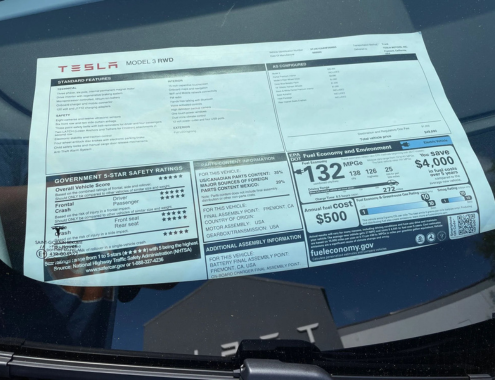When you’re in the market for a new car, one of the key terms you’ll encounter is the Manufacturer’s Suggested Retail Price (MSRP). Understanding what MSRP means in cars and how it’s determined can help you make informed decisions during your car-buying process.
MSRP Meaning In Cars

MSRP is an acronym for “manufacturer’s suggested retail price,” which is the price that a vehicle’s manufacturer recommends it be sold for. This price is strategically set to ensure that all parties involved— the manufacturer, dealer, and intermediaries— can generate a profit. The MSRP serves as a guideline for pricing, but as the name suggests, it’s only a recommendation.
Most automakers sell vehicles through the traditional dealership model, where the dealer acts as a third party. Dealers purchase vehicles from the manufacturer at a lower price and then sell them to consumers at the MSRP, which is higher, allowing the dealer to make a profit on each car sold. However, the actual sale price can vary, often being higher or lower than the MSRP, depending on factors such as demand, market conditions, and dealer pricing strategies.
Also, read: What is Car Poor?
What’s the difference between MSRP and Base Price?
The base price of a vehicle refers to its cost without any additional options or features. On the other hand, the Manufacturer’s Suggested Retail Price (MSRP) represents the vehicle’s price as displayed in the showroom, which includes not only the base price but also any optional features, destination charges, and dealer add-ons.
For instance, a vehicle with a base price of $36,000 might have an MSRP of $41,000 due to the inclusion of $5,000 worth of options and fees. These additional costs increase the MSRP significantly above the base price. It’s important to note that the base price does not include the destination charge, which is the cost of delivering the vehicle to the dealership. This fee, which can range from around $995 to over $2,000, is included in the MSRP shown on the vehicle’s window sticker.
The base price typically reflects the most affordable version of a car. For example, if an expert review mentions that the 2024 Honda CR-V starts at approximately $30,850, including a $1,350 destination charge, this would be the cost for the lowest trim level, such as the CR-V LX.
However, most buyers opt for a model with additional features rather than the least expensive version. So, while the base model of a new Honda CR-V LX may start at nearly $31,000, it’s reasonable to expect that a more feature-rich version like the CR-V EX-L would cost closer to $36,000 with the options most buyers prefer.
The Origin of the Window Sticker
The MSRP is prominently displayed on the window sticker of a vehicle, also known as the Monroney label. This label is named after a congressman from Oklahoma, Almer Stillwell “Mike” Monroney, who sponsored the 1958 Automobile Information Disclosure Act. This act made it mandatory for manufacturers to include a label on every new car, detailing the following:
- Base Price: The starting cost of the vehicle.
- Accessories and Options: A list of all additional features and their respective costs.
- Total Price: The sum of the base price and any additional features, which equals the MSRP.
What Information Does the Monroney Label Provide?
The Monroney label offers a comprehensive view of the car you’re considering. Here’s what you can expect to find:
- Vehicle Identification Number (VIN): A unique serial number that identifies the specific car.
- Exterior and Interior Colors: The car’s paint color and interior trim details.
- Standard Features: A list of all the equipment included in the base price.
- Optional Features: Any extra equipment or packages added by the manufacturer, along with their costs.
- Transportation Fee: The cost of delivering the vehicle from the manufacturer to the dealer.
Dealer Add-Ons and Markups

In addition to the standard MSRP, dealers might add their own charges. These can include:
Dealer-Installed Accessories
Dealers often install additional features like body side moldings, pinstripes, or door edge guards. These additions will be listed separately on the window sticker, with their respective costs.
Additional Dealer Markup (ADM)
For vehicles in high demand with low availability, dealers might add an Additional Dealer Markup (ADM). This is an extra charge above the MSRP, often ranging from a few hundred to several thousand dollars. While some dealers justify this by citing high demand, it’s important to remember that this markup doesn’t add any value to the vehicle.
The Ethics of Dealer Markups
Charging more than the MSRP can lead to customer dissatisfaction in the long run. Buyers may later realize that the extra money paid didn’t add any tangible value to the car, leading to potential regret. From a customer loyalty standpoint, it’s advisable for dealers to stick to the MSRP, even for high-demand vehicles.
Understanding Dealer Profit Margins
The profit margin built into a car’s MSRP varies depending on the vehicle’s price:
- Lower-Priced Cars: Typically, these have a smaller profit margin, often between 2-3%. For example, on a $15,000 car, the margin might be just $300.
- Higher-Priced Cars: Luxury brands like Mercedes-Benz might have margins ranging from 8-12%. This allows for more room to offer discounts while still making a profit.
Despite these margins, dealerships often rely on high sales volume rather than large individual profits to achieve overall profitability.
Also, read: 9 Money Habits Keeping Poor
Final Thoughts
If you are thinking of buying a vehicle or just want to learn more about the car market pricing, consider checking online car sales references, such as the Kelley Blue Book or Edmunds.com. Here you will be able to see how far below the list price your chosen car usually sells for. Car lots are also legally required to display a Monroney sticker price. This includes the list price along with the base price and any extra options charges, as well as other information. The Monroney sticker doesn’t need to show invoice price, so you may need to do some research before negotiating.


0 Comments